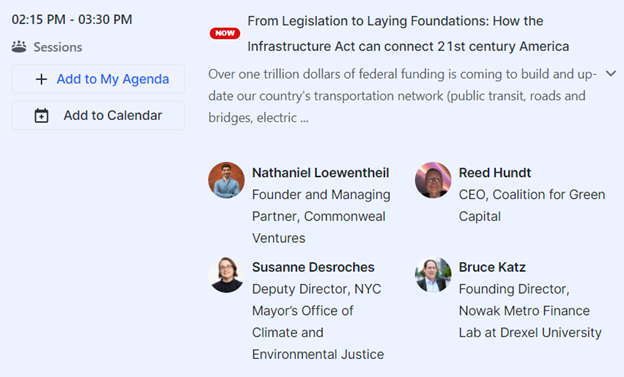
Yale Economic Development Symposium
On February 11, 2022, Metro21 attended the Yale Economic Development Symposium: From Legislation to Laying Foundations: How the Infrastructure Act Can Connect 21st Century America.
Nate: “Why was the bill able to garner bipartisan support?”
- Bruce: Deferral of reality and cumulative effect; pressure from voters; voter recognition of the federal government’s role in maintaining and updating infrastructure
- Susanne: People’s recognition of the US lack of investment and advancement in infrastructure compared to global levels of investment
- Previous administration had entertained the idea of public-private partnerships to fund infrastructure; reforming the structure of funding between federal, state and local governments
- Reed: Build Back Better Framework coupled with increased federal government mobilization on vaccine rollout created momentum and new administration’s general agenda for infrastructure (communication, transportation, etc) investment (note: there were leftover funds from the covid bill that were picked up by Republicans to allocate to infrastructure investment)
- First iteration of legislation: Republicans joined support for infrastructure investment movement but selected the ‘least reform-oriented’ issues and left out issues like decarbonization and climate change
- Biden Administration chose to move ahead with bill despite lack of Democratic support given changes from Republicans
- We “cannot conclude that this bill marks a new era of bipartisan collaboration”
Nate: “In terms of funding allocations, what are the most important elements of the bill? Do you think they are appropriately tailored to the scope of the challenge?”
- Bruce: The bill does not respond to the needs of the moment; given disruptions of the pandemic and radical changes in manufacturing, commerce, consumerism, etc - the bill does not respond quite to this phenomenon
- Treats infrastructure like infrastructure instead of a platform for achieving innovative growth - traditional view of infrastructure and not modern perspective of infrastructure
- Not much capacity or planning for execution and implementation of infrastructure investment; small towns/cities are not even aware enough about new government funding programs and do not have the capacity nor the norms and models to help move forward
- Lack of coordination at the county, city, state level - are they prepared for implementation? From Washington, the bill looks fantastic but on the ground small governments are struggling to implement and follow through
- Susanne: NYC lacks budget and has not had an influx of federal funding in many years so this is very good news for NYC
- Implement systems for continued funding after large sums from feds - how to create sustainability and longevity
- Bruce: took approximately 25 years for the feds to recognize the need for universal broadband and access to modern communication infrastructure; perception around this aspect of infrastructure has changed and now people are moving towards affordability and accessibility
Nate: “What are some areas that are not being considered in the bill?”
- Bruce: COVID and the geography of work; influx of infrastructure given funding from the feds but new considerations about the distribution of people across the country and urban areas
- Housing was left out of the equation; eviction moratorium is done, home princess increased, and homelessness has also increased
- Both cyclical and structural effects on the geography of work
- Remote work has longitudinal effects on cities and housing affordability crisis remains unaddressed by the new infrastructure bill
- Susanne: building retrofitting for energy efficiency - is that cost only going to be borne by homeowners?
- Reed: 1) fractionized and politicization of health care; 2) power system
General Reflections and Advice Moving Forward
- Susanne: “You can’t just throw money around at a problem; without state and local capacity, money will be left on the table; there are not existing models of implementation that can help guide how money will be spent”
- Figure out how to partner with the right entities and how to make that process collaborative
- Communicate need on the ground to stakeholders in the upper levels; communication and collaboration are critical
- Nate: Strong market demand, incentives and market structure can help foster a market solution (ex. fueling stations across the country)
- Reed: holistic community solutions, provided the example of decarbonization - how, specifically will this be achieved? From the smallest/initial person or groups involved to the largest group or most powerful people final steps
- Bruce: networks of stakeholders are critical in the success of the implementation process; horizontal integration and collaboration
- Progress has to be inclusive of vulnerable segments of the population
